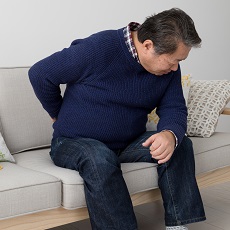
Pain is a signal in your nervous system that something may be wrong. It is an unpleasant feeling, such as a prick, tingle, sting, burn, or ache. Pain may be sharp or dull. You may feel pain in one area of your body, or all over. There are two types: acute pain and chronic pain. Acute pain lets you know that you may be injured or a have problem you need to take care of. Chronic pain is different. The pain may last for weeks, months, or even years. The original cause may have been an injury or infection. There may be an ongoing cause of pain, such as arthritis or cancer. In some cases there is no clear cause. Environmental and psychological factors can make chronic pain worse.
Many older adults have chronic pain. Women also report having more chronic pain than men, and they are at a greater risk for many pain conditions. Some people have two or more chronic pain conditions.
- Chronic Pain (National Library of Medicine)... over. There are two types: acute pain and chronic pain. Acute pain lets you know that you may ... have problem you need to take care of. Chronic pain is different. The pain may last for weeks, ...
- ... following organizations are good resources for information on chronic pain: American Chronic Pain Association -- www.acpanow.com Centers ...
- ... your waist, leads to pain. Many people with chronic back pain have arthritis. Or they may have extra wear ...
- Chronic Pain/Start Here ... Chronic Pain ... Non-Drug Pain Management/Specifics ... Non-Drug Pain Management ... National Center for Complementary and Integrative Health ... From ...
- Chronic Pain and PTSD: A Guide for Patients (National Center for PTSD)Chronic Pain/Related Issues ... Chronic Pain ... Post-Traumatic Stress Disorder/Related Issues ... Post-Traumatic Stress Disorder ... National Center for PTSD ... Physical, Somatic, ...
- Employees with Chronic Pain (Office of Disability Employment Policy)Chronic Pain/Related Issues ... Chronic Pain ... Office of Disability Employment Policy ... Accommodation and Compliance: Chronic Pain
- Managing chronic back pain means finding ways to make your back pain tolerable so you can live your life. You may ... Elsevier; 2019:chap 48. Lemmon R, Roseen EJ. Chronic low back pain. In: Rakel D, ed. Integrative Medicine . 4th ed. ...
- Narcotics are strong medicines that are sometimes used to treat pain. They are also called opioids. You take them only when your pain ...
- Complex Regional Pain Syndrome (National Library of Medicine)Complex regional pain syndrome (CRPS) is a chronic pain condition. It causes intense pain, usually in the arms, hands, legs, or feet. It may happen after an injury, either to a nerve ...
- 9 Things You Should Know About Chronic Pain and Complementary Health Approaches
 (National Center for Complementary and Integrative Health) ... some complementary health approaches may help people manage chronic pain.
(National Center for Complementary and Integrative Health) ... some complementary health approaches may help people manage chronic pain.



